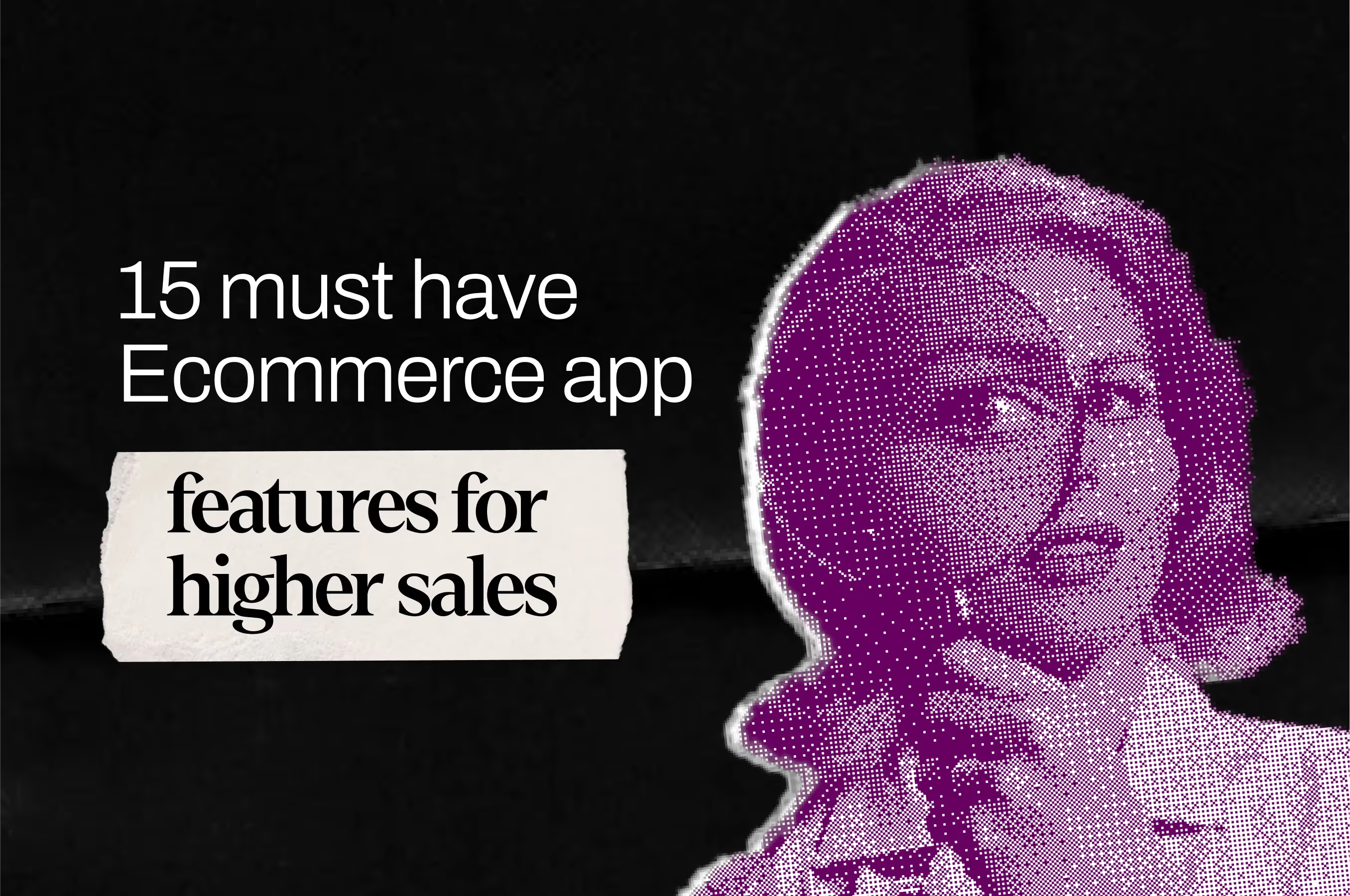With 90% of eCommerce traffic coming from mobile devices, it's clear that mobile needs to be your primary channel if you want to thrive in this industry.
But let's be real—just optimizing your website for mobile won’t cut it. Mobile-friendly websites simply can’t compete with the experience a native app offers.
Did you know that eCommerce apps generate three times more sales than mobile websites? That’s because apps deliver a superior customer experience and have the power to bring customers back, even if they don’t convert on their first visit.
In this blog, we’re sharing the top 15 must-have features for your eCommerce app to help you boost sales and keep your customers coming back for more.
1. Stylish, intuitive, and easy-to-use interface
The first thing your customers notice when they open your app is its design. A modern, sleek interface creates a strong first impression, making customers more likely to stay and shop.
But good looks aren’t enough—your app’s navigation needs to be intuitive, too. If users can’t easily find what they’re looking for, they’re likely to leave.
And 52% of users said that a bad mobile experience made them less likely to engage with a company.
In fact, 67% of mobile users say that “pages and links being too small to click on” is a major barrier to mobile shopping.
Here are some tips to make your app interface intuitive:
- Use clear and easy-to-tap buttons.
- Ensure fast loading times for all pages.
- Optimize your app for one-handed use.
- Keep the design clean and clutter-free.
- Make sure the checkout process is simple and straightforward.

[[cta]]
2. Seamless signup options
First impressions matter, and a seamless signup process sets the tone for a positive user experience. The easier it is to sign up, the more customers you’ll convert.
A hassle-free registration feels like a warm welcome to your store. To make the signup process seamless, offer multiple options such as:
- Email signups
- Phone number with OTP
- Social media logins like Google and Facebook
By providing these options, you reduce friction, which leads to happier customers and fewer drop-offs, ultimately driving higher sales.

3. AI-powered intelligent search bar
Search behavior has evolved, and your app needs to keep up. Gone are the days of exact match searches; today’s customers expect advanced features like natural language processing (NLP) for auto-suggestions and handling common spelling errors.
For example, if a user searches for "sunscream," your app should know they meant "sunscreen." And if your app is not capable of this, you must know that there’s a high chance that 68% of your customers will go away and never return.

Beyond basic search, consider adding voice and visual search options. These advanced features can significantly enhance the user experience, leading to higher conversions and increased sales.
4. App-push notifications
Push notifications are a powerful tool to keep your customers engaged and coming back for more. Unlike websites, mobile apps allow you to stay connected with your users through timely updates.
During peak sales seasons like BFCM, running out of stock is common, but you can maintain customer trust by notifying them when items are back in stock.
Done right, push notifications can significantly boost sales. And did you know that around 70% of app users find push notifications useful? About 40% of users engage with these notifications within an hour of receiving them.
💡Pro tip: When you create your eCommerce app with Appbrew, you can send push notifications that are designed to get you more sales. With rich media support, our app push notifications delivers up to 10x better click-through rates than traditional marketing channels. And our eCommerce mobile app builder also allows you to send app push notifications to dynamic segments of your customer base — which helps you get more sales.

5. Consistent omnichannel experience
Looking at the increasing competition in the eCommerce market, selling across multiple channels is no longer optional—it’s a necessity.
Mobile apps does wonders in providing a seamless shopping experience across all platforms, known as the omnichannel experience.
Customers expect consistency, whether they’re shopping online, on an app, or in-store. Keep in mind that 80% of customers prefer using mobile phones and apps for purchases over websites.
To ensure a consistent customer experience:
- Sync all your channels for uniformity.
- Keep product information, pricing, and promotions consistent.
- Ensure smooth transitions between different platforms (e.g., app to website).

Many eCommerce mobile app builders only allow you to create an app — and though it might work in getting some sales, managing it becomes tough. Whenever you change something on your eCommerce website, you have to change it manually on your app too.
But that’s not the case with Appbrew. Its end-to-end integration with Shopify ensures whatever pricing, inventory, or product changes you make on the store is automatically synced on the eCommerce mobile app.
6. Virtual try-on
One of the biggest hesitations people have about online shopping is not being able to see how a product looks on them before buying. That’s where the virtual try-on feature comes in.
By allowing customers to virtually try on items like clothing, accessories, or even makeup, you’re bridging the gap between offline and online shopping. It’s a game-changer that gives your customers confidence in their purchases.
When they can see a product on themselves, they’re more likely to feel ownership over it, thanks to something called the Endowment Effect. This cognitive bias makes people more inclined to buy something once they’ve pictured it as their own.
This feature not only improves customer satisfaction but also drives more sales by reducing the uncertainty associated with online shopping.
7. Personalized product recommendation
Shopping decisions are deeply personal, and your app should reflect that. By integrating intelligent algorithms that suggest products based on a user’s preferences, past purchases, or even their browsing history, you can create a more tailored shopping experience.
Let’s say there’s a customer who’s been eyeing a certain brand of sneakers; your app’s algorithm should be able to pick up on this and recommend other products from the same brand or similar styles.

The more your app learns from user behavior, the better it becomes at making spot-on recommendations.
Over time, as you gather more first-party data from app interactions, the accuracy of these recommendations only improves, leading to more conversions. Personalization is more than just a nice-to-have feature—it’s a powerful tool that can significantly increase your sales.
8. In-app order tracking
Once a customer places an order, the anticipation of waiting for it to arrive begins. With in-app order tracking, you can satisfy their curiosity and keep them engaged.
This feature lets users track their order in real time, from the moment it’s placed to when it’s shipped and finally delivered. Regular updates keep customers informed and excited, reducing any anxiety about their purchases.
If your app can send notifications about the order’s status, even better—customers appreciate being in the loop.

A seamless tracking experience encourages repeat purchases because customers know they can trust your store to keep them updated every step of the way. Don’t miss out on this feature; it’s a must for keeping customers satisfied and coming back for more.
9. Return/exchange request handling
No matter how great your products are, returns and exchanges are inevitable. The key is to make the process as simple and painless as possible.
Unfortunately, some businesses make the mistake of directing customers to their website for returns, complicating the process and frustrating users.
If you want customers to keep coming back, ensure they can handle returns and exchanges directly through your app. Clear instructions and a straightforward process will make them feel valued, not annoyed.
A dedicated return page within the app, where customers can easily request returns or exchanges, is essential. By simplifying this often-dreaded process, you’re not just keeping customers happy—you’re turning a potentially negative experience into a positive one, increasing the likelihood of future purchases.
10. Conversational and generative AI chatbot
Being there for your customers whenever they need you can significantly enhance their shopping experience.
With a conversational and generative AI-powered chatbot, your app can provide support 24/7, answering questions, guiding users, and even recommending products based on their preferences. This not only makes customers feel supported and appreciated, but it also drives more sales by offering personalized suggestions at just the right moment.
For example, if a customer is browsing dresses, your chatbot could suggest matching accessories or shoes, boosting the chances of an upsell.
Implementing a chatbot like this also helps reduce the need for a large customer service team, saving you costs while keeping your customers happy.
Brands like Myntra have successfully used AI chatbots to understand customer context and recommend products, leading to increased sales and customer satisfaction.

[[cta2]]
11. Geolocation
With geolocation, your app can automatically detect and input a customer’s location, eliminating the need for them to manually enter their address.
This not only speeds up the checkout process but also allows for precise delivery tracking.
Customers appreciate the convenience, as it reduces errors and enhances their overall shopping experience.
Beyond simplifying the purchase process, geolocation also provides valuable data insights for your business. Understanding where your customers are ordering from can help you optimize logistics and improve delivery times.
It's a win-win: customers enjoy a hassle-free experience, and you gain critical data for refining your operations.
💡Pro Tip: Make sure your geolocation feature offers an option to manually adjust the location. This way, if the automatic detection isn’t spot-on, customers can easily correct it, preventing any delivery mishaps.
12. Wishlist and favorites
The wishlist feature in the eCommerce app is like a personal shopping assistant for your customers. It lets them save products they’re interested in but aren’t ready to purchase just yet. This feature is incredibly useful for turning window shoppers into buyers.
Customers can return to their wishlist at any time and find exactly what they liked earlier, without having to search for it again.
You can also use this feature by sending notifications when items on their wishlist go on sale or are about to go out of stock, nudging them to make a purchase.

By helping customers keep track of their favorite items, you enhance their shopping experience and encourage repeat visits to your app, which can lead to higher sales.
13. Advanced filtering and sorting
When your eCommerce app has an extensive product catalog, advanced filtering and sorting options become crucial.
Customers need to find what they’re looking for quickly, without getting lost in a sea of products.
Filters allow users to narrow down their search by various criteria, such as price, brand, or availability. This feature streamlines the shopping experience by cutting down on the time customers spend searching for products.

With fewer steps needed to locate the perfect item, users are more likely to complete their purchases, which boosts your conversion rates.
Offering a range of filtering options not only enhances user satisfaction but also demonstrates that your app is designed with their convenience in mind.
14. Voice shopping
Voice shopping is rapidly becoming a must-have feature in modern eCommerce apps. With the rise of voice assistants like Alexa and Google Assistant, customers are increasingly comfortable using voice commands to search for and purchase products.
This feature adds a new layer of convenience, allowing users to shop hands-free. For example, a customer using your app while cooking can simply say, “Order more olive oil,” and the app takes care of the rest.
Voice shopping isn’t just a novelty—it’s a powerful tool that caters to busy customers who value efficiency.
As this technology continues to grow, integrating voice shopping into your app will keep you ahead of the curve and provide a seamless, futuristic shopping experience.
15. Quick and smooth checkout experience
A quick and smooth checkout process can significantly impact your app’s success. The easier it is for customers to complete a purchase, the more likely they are to follow through.
Implementing one-click payment options can drastically reduce the friction that often causes cart abandonment.

By offering multiple payment gateways, such as PayPal, Google Pay, and Amazon Pay, you cater to your customers’ preferences, making the payment process more convenient.
💡Pro Tip: Include a guest checkout option for first-time buyers who may not want to create an account. This removes a common barrier to purchase and can lead to more conversions.
[[cta3]]
Bonus: Pick the right eCommerce mobile app builder to deliver these features
Wrapping up, it's clear that many eCommerce app builders out there are focused on just one thing: getting your app live as quickly as possible.
But what happens next?
You're often left with an app that isn’t optimized for driving sales and comes with frustrating limitations when it comes to adding the features you really need. You might find yourself stuck with an app that doesn’t fully serve your business or your customers, leading to missed opportunities and potential sales.
This is where Appbrew steps in. Unlike other builders, Appbrew is designed to take care of everything, from creating a stunning design to ensuring top-notch usability and including every feature you can think of.
Whether it’s advanced filtering, push notification, segmentation, or recommendation, Appbrew has you covered.
And the best part? Your Appbrew-built app integrates seamlessly with your Shopify store, making the development and management process smooth and quick.
Don’t settle for less. Book a demo with Appbrew today!











